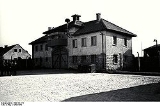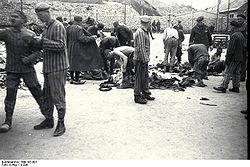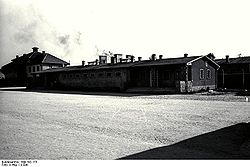
Gusen
Encyclopedia

Austria
Austria , officially the Republic of Austria , is a landlocked country of roughly 8.4 million people in Central Europe. It is bordered by the Czech Republic and Germany to the north, Slovakia and Hungary to the east, Slovenia and Italy to the south, and Switzerland and Liechtenstein to the...
n territory. Originally called "Mauthausen II", the camp consisted of three camps and toward the end of the war, was annexed to Mauthausen concentration camp. It was part of the Mauthausen-Gusen concentration camp
Mauthausen-Gusen concentration camp
Mauthausen Concentration Camp grew to become a large group of Nazi concentration camps that was built around the villages of Mauthausen and Gusen in Upper Austria, roughly east of the city of Linz.Initially a single camp at Mauthausen, it expanded over time and by the summer of 1940, the...
complex.
History
On May 25, 1938, the first lots of land were acquired at Gusen by the SS company DESTDEST
The D. E. S. T. , was an SS owned company originally created to procure and manufacture building materials for state construction projects in Nazi Germany DEST was a subsidiary company of Amtsgruppe W of SS-Wirtschafts- und Verwaltungshauptamt...
(Deutsche Erd- und Steinwerke GmbH or "German Earth & Stone Works, Inc."). Mauthausen concentration camp was founded later.
The existence of important stone quarries at Gusen was the key for the SS administrators' decision to establish a system of two concentration camps at Gusen and nearby Mauthausen. By 1939, the work carried out by inmates of "Mauthausen" at Gusen exceeded the work done at the Mauthausen "Wienergraben" quarry — a period when both concentration camps were makeshift installations and hundreds of inmates of the "Mauthausen" camp had to walk to the Gusen quarries every day.

World War II
World War II, or the Second World War , was a global conflict lasting from 1939 to 1945, involving most of the world's nations—including all of the great powers—eventually forming two opposing military alliances: the Allies and the Axis...
, with its own administrative infrastructure, Werkgruppenleitung, at the nearby town of Sankt Georgen an der Gusen
Sankt Georgen an der Gusen
Sankt Georgen an der Gusen is a small market town in Upper Austria, Austria, between the municipalities of Luftenberg and Langenstein...
(hereinafter mentioned as "St. Georgen"). Thus, both St. Georgen and Gusen became the siege of Granitwerke Mauthausen, from which DEST operated its business at the quarries of the dual concentration camp system, Mauthausen-Gusen.
From 1943 on, DEST of St. Georgen shifted production from granite to armament products. DEST received several contracts and offered slave labour from its concentration camps at Gusen to companies like Heereszeuganstalt Wien, Steyr-Daimler-Puch AG or Messerschmitt GmbH of Regensburg
Regensburg
Regensburg is a city in Bavaria, Germany, located at the confluence of the Danube and Regen rivers, at the northernmost bend in the Danube. To the east lies the Bavarian Forest. Regensburg is the capital of the Bavarian administrative region Upper Palatinate...
, and established huge armament plants at St. Georgen and Gusen, a good deal of it underground and bomb-proof. The most important such joint-venture was the project B8 Bergkristall - Esche II, where DEST established and operated a huge underground assembly plant for Messerschmitt Me-262 jet planes.

- Gusen I, for the inmates assigned to the activities of DEST at Gusen;
- Gusen II, for the inmates assigned to the activities of DEST at St. Georgen; and
- Gusen III, for the inmates assigned to the activities of DEST at LungitzLungitzLungitz is a village in the community of Katsdorf, Perg district of Upper Austria, Austria.During World War II it was the site of slave labour and the "Gusen III" sub-camp of the Mauthausen-Gusen system later on. Although camp Gusen III was not opened earlier than December 1944, inmtes of camp...
.
Until January 1944, the Gusen concentration camps (called "Mauthausen II" in 1939) were widely independent from the nearby Mauthausen concentration camp. They had their own independent numbering system, death register, construction directorate, guard battalion, and post office. It was only in the final phase of the war that it was annexed, like countless other satellites, to the concentration camp at Mauthausen. Nevertheless, especially in 1944, the number of inmates at the Gusen camps was double that at the related camp at Mauthausen. Even the number of victims appears to be significantly higher compared to the Mauthausen camp.

Soviet Union
The Soviet Union , officially the Union of Soviet Socialist Republics , was a constitutionally socialist state that existed in Eurasia between 1922 and 1991....
occupation forces
Military occupation
Military occupation occurs when the control and authority over a territory passes to a hostile army. The territory then becomes occupied territory.-Military occupation and the laws of war:...
early decided to continue the operation of the former DEST installations at Gusen, under the name of "Granitwerke Gusen", after the liberation of the camps, while dedicating the economically unimportant Mauthausen part of the double camp system to a memorial site. This caused the Gusen camps to become more or less forgotten for decades, while all attention was given to the much smaller Mauthausen site.
The Austrian government took until 2000 to decide questions of property concerning the huge underground plants at St. Georgen and Gusen, but by the early 1960s, survivors had grown concerned that all evidence of the Gusen camps would be erased from what was fast becoming a middle class neighbourhood. Entirely with their own funds, survivors bought the plot of land surrounding the crematorium and built the Gusen Memorial, dedicated on May 8, 1965. Nearly forty years later, in 2004 the government of Austria, with generous contributions from Poland, built a tiny museum at Gusen to commemorate the 40,000 nearly forgotten victims.

